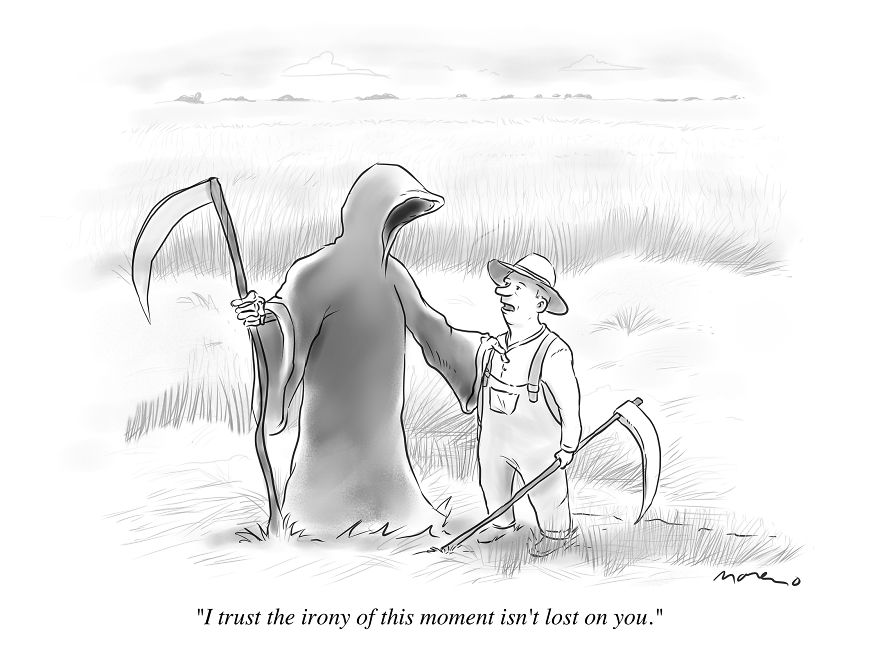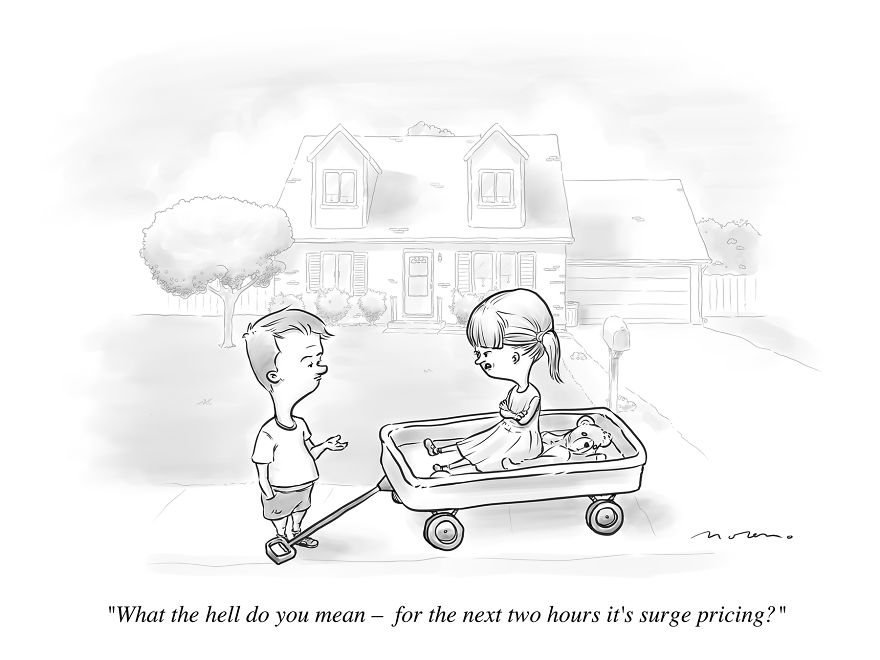The legendary Bob Mankoff, who recently stepped down as cartoon editor at the New Yorker (1997 to 2017), said it took approximately 2,000 submissions to the magazine before ever getting an acceptance letter.
I don't know why this information inspired me when it should have left me in a fetal position, whimpering for my mother.
Obviously, I have no illusions that winning at this sort of endeavor comes easy— especially now, with so much talent sending their cartoon drawings to the same address every week.
To paint an accurate picture, the number of drawing ideas reviewed weekly at the New Yorker is roughly 1,000. The number of these funny cartoons in each issue is about 12 to 20? I've always been a bit of a hack when it comes to math, but even I can see the New-Yorker odds and myself are waving at each other across an almost immeasurable expanse.
More info: johnart.org
This post may include affiliate links.
Then there's the sense of humor.
It's distinctly New Yorker-ish. Can I pull that kind of dry, subtle, epiphany-esque kind of funny out of my tailpipe?
It remains to be seen, but I'll continue to try. Still, the lottery is the lottery— you can't win if you don't play.
Crossfit made the fly so strong he just pulls the frog's mouth open and saves himself. The End.
Load More Replies...I initially thought the frog to the right had a snake painted on it's face
At first I thought the frog to the right had a snake painted on it's face...
And, I'd still be making these New Yorker cartoons regardless of the outcome, because it seems I don't know any better. This has created an interesting situation; forcing me to examine (and reexamine) my reasons for trying out for the "show".
1. Turns out; I love cartooning more than I thought. So, scribbling and searching out the absurd is, in my humble opinion, an excellent way to spend a few hours each day.
2. Having this near-impossible goal has forced me to focus on the task at hand. I submit to you— it is easier to drown a fish than get the average artist to focus for long periods... on anything. In the process, I've become a much better (and disciplined) cartoonist and illustrator.
3. As cliché as it sounds, the journey is the reward. I'm an illustrator by trade, doing mostly science and technological demonstratives, infographics, etc. Cartooning is vastly different and being silly is just plain cathartic. Was it Confucius who said, "Choose a job you love and you'll never work a day in your life?" I can't remember, maybe it was Bono— smug bastard.
Anywhoodle, I see so much brilliance on Bored Panda. I'm always inspired by the talented contributors and hope there aren't artists out there hiding their brilliance because of intimidation or fear of criticism.
In the meantime, I forge ahead with zero expectations and the certainty of either getting published in the New Yorker one day or having enough cool drawings for my own coffee table book.
Either one works for me.
Thanks for reading.
Ha ha ha! I love it! I'd totally watch a tv show where one of the cops is a clown.
You should watch psych. The "official psychic" is the clown...
Load More Replies...aaaaaaaaaaaaaaaaaaaaaaaaaaaaaaaaaaaaaaaaaaaaaaaaaaaaaaaaaaaaaaaaaaaaaaaaaaaaaaaaaaaaaaaaaaaaaaaaaaaaaaaaaaaaaaaaaaaaaaaaaaaaaaaaaaaaaaaaaaaaaaaaaaaaaaaaaaaaaaaaaaaaaaaaaaaaaaaaaaaaaaaaaaaaaaaaaaaaaaaaaaaaaaaaaaaaaaaaaaaaaaaaaaaaaaaaaaaaaaaaaaaaaaaaaaaaaaaaaaaaaaaaaaaaaaaaaaaaaaaaaaaaaaaaaaaaaaaaaaaaaaaaaaaaaaaaaaaaaaaaaaaaaaaaaaaaaaaaaaaaaaaaaaaaaaaaaaaaaaaaaaaaaaaaaaaaaaaaaaaaaaaaaaaaaaaaaaaaaaaaaaaaaaaaaaaaaaaaaaaaaaaaaaaaaaaaaaaaaaaaaaaaaaaaaaaaaaaaaaaaaaaaaaaaaaaaaaaaaaaaaaaaaaaaaaaaaaaaaaaaaaaaaaaaaaaaaaaaaaaaaaaaaaaaaaaaaaaaaaaaaaaaaaaaaaaaaaaaaaaaaaaaaaaaaaaaaaaaaaaaaaaaaaaaaaaaaaaaaaaaaaaaaaaaaaaaaaaaaaaaaaaaaaaaaaaaaaaaaaaaaaaaaaaaaaaaaaaaaaaaaaaaaaaaaaaaaaaaaaaaaaaaaaaaaaaaaaaaaaaaaaaaaaaaaaaaaaaaaaaaaaaaaaaaaaaaaaaaaaaaaaaaaaaaaaaaaaaaaaaaaaaaaaaaaaaaaaaaaaaaaaaaaaaaaaaaaaaaaaaaaaaaaaaaaaaaaaaaaaaaaaaaaaaaaaaaaaaaaaaaaaaaaaaaaaaaaaaaaaaaaaaaaaaaaaaaaaaaaaaaaaaaaaaaaaaaaaaaaaaaaaaaaaaaaaaaaaaaaaaaaaaaaaaaaaaaaaaaaaaaaaaaaaaaaaaaaaaaaaaaaaaaaaaaaaaaaaaaaaaaaaaaaaaaaaaaaaaaaaaa
Some time has passed since I've made this post. I've sold some cartoons but haven't been accepted by the New Yorker—In their defense, my submissions to them have been sparse. You have to be relentless and consistent.
You can't make a wrong right because there is something that is more wrong
Load More Replies...I think you have to just be zen about rejection. It cannot be your focus if you want to do this professionally. For me, I try to learn from my failures and streamline my gags. I look at many other cartoonists and try to learn from their successes. We all have to deal with rejection. My biggest epiphany would be that I will continue to do cartooning for the joy of doing it. If I concentrate on that, I will improve. I have sold some cartoons, but I experience rejection about 75% of the time. It's just part of the business and there's a lot of talent out there. Just keep at it. You deserve to be published just like everyone else. If rejection bothers you, I'd consider another way to exercise your creative demons.
The fear of rejection subsides, eventually. It has for me. I'd encourage anyone who's trying to get published to remove their concerns about rejection from the equation. Just produce. The rest will work itself out. Whenever I send cartoons to a publication I sort of forget about it and move on to the next thing. It helps to keep the ball rolling and not wait around to see if something sold.
I'll give you a sneak peek into the creative process of my cartoon. It usually starts with a gag. I'll spend time just brainstorming on gag ideas before I ever start drawing. I like to have a handful of ideas before the sketching phase. The rest of the time is spent on execution. Making a gag funny and understated at the same time is my objective. Of course, making it understandable helps. Sometimes I fail at this, but it doesn't seem to discourage me.
In terms of influences, Gary Larson and Bill Watterson have been one of the most influential cartoonists for me, and there are many more than I can mention.
I've been working on a children's book and a new batch of cartoons. I have two new books in the works and I'm always looking for that next gag to turn into a cartoon. I can't emphasize enough how important it is to be productive. Work every day—even when you don't feel like it, or feel like the attempt was a failure. Not trying or making the effort—that's when we really fail.
Those are interesting. But, to be honest, I have hard time understanding some of them. Not because I don't have a sense of humour, but because my vocabulary is a bit limited, since I'm a foreigner.
I feel you. But it's not the language for me, but the cultural differences.
Load More Replies...They are. I've watched a tv segment on these once and the guidelines are pretty strict. There's no real set criteria for getting accepted but usually the reasons for rejection are that they are "...too lowbrow, too politically incorrect, too dark, too weird, too political, too difficult to get, too dumb, too bad, or too dirty. " to quote Matthew Diffee who was one of the cartoonists who has managed to be successfully published more than 200 times in the New Yorker.
Load More Replies...Thank you all for your thought-provoking comments. Even the less-than-favorable ones mean a lot. My only objective will always be to improve. This helps!
Wait, these were rejected? I laughed at all of them, someone at that office doesn't get comedy.
They are fine. Nothing wrong with them it's just you are sending them to a place which has a very narrow funnel of acceptance. Cartoons are well drawn and can carry some humor which is fine. Youare sending them to aplace which appears to regard itself as very exclusive and so they will be limited into what they feel they can accept at any one time
These are all fine. There's nothing wrong with them. They are just being submitted to a place where there is a tight funnel of acceptance. It doesn't mean that they are not good , or funny. They are. Where you are sending them is very exclusive and probably quite limited into what it does and does not accept
I very much like your measured, detailed, and yet fully surreal drawing style.
I liked them a lot. As soon as I go to work for the New Yorker you're in.
Those are interesting. But, to be honest, I have hard time understanding some of them. Not because I don't have a sense of humour, but because my vocabulary is a bit limited, since I'm a foreigner.
I feel you. But it's not the language for me, but the cultural differences.
Load More Replies...They are. I've watched a tv segment on these once and the guidelines are pretty strict. There's no real set criteria for getting accepted but usually the reasons for rejection are that they are "...too lowbrow, too politically incorrect, too dark, too weird, too political, too difficult to get, too dumb, too bad, or too dirty. " to quote Matthew Diffee who was one of the cartoonists who has managed to be successfully published more than 200 times in the New Yorker.
Load More Replies...Thank you all for your thought-provoking comments. Even the less-than-favorable ones mean a lot. My only objective will always be to improve. This helps!
Wait, these were rejected? I laughed at all of them, someone at that office doesn't get comedy.
They are fine. Nothing wrong with them it's just you are sending them to a place which has a very narrow funnel of acceptance. Cartoons are well drawn and can carry some humor which is fine. Youare sending them to aplace which appears to regard itself as very exclusive and so they will be limited into what they feel they can accept at any one time
These are all fine. There's nothing wrong with them. They are just being submitted to a place where there is a tight funnel of acceptance. It doesn't mean that they are not good , or funny. They are. Where you are sending them is very exclusive and probably quite limited into what it does and does not accept
I very much like your measured, detailed, and yet fully surreal drawing style.
I liked them a lot. As soon as I go to work for the New Yorker you're in.

 Dark Mode
Dark Mode 

 No fees, cancel anytime
No fees, cancel anytime 












































































